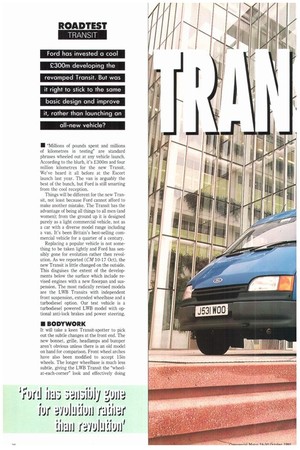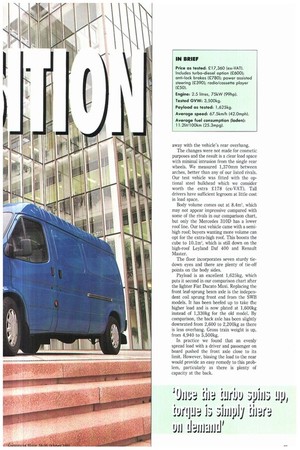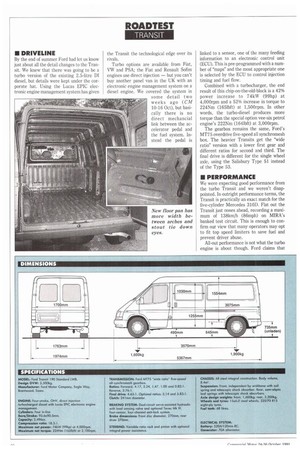Ford has invested a cool £300m developing the revamped Transit.
Page 28

Page 29

Page 30

Page 31

Page 32

If you've noticed an error in this article please click here to report it so we can fix it.
But was it right to stick to the same basic design and improve it, rather than launching an all-new vehicle?
• "Millions of pounds spent and millions of kilometres in testing" are standard phrases wheeled out at any vehicle launch. According to the blurb, it's £300m and four million kilometres for the new Transit. We've heard it all before at the Escort launch last year. The van is arguably the best of the bunch, but Ford is still smarting from the cool reception.
Things will be different for the new Transit, not least because Ford cannot afford to make another mistake. The Transit has the advantage of being all things to au men (and women); from the ground up it is designed purely as a light commercial vehicle, not as a car with a diverse model range including a van. It's been Britain's best-selling commercial vehicle for a quarter of a century.
Replacing a popular vehicle is not something to be taken lightly and Ford has sensibly gone for evolution rather then revolution. As we reported (CM 10-17 Oct), the new Transit is little changed on the outside. This disguises the extent of the developments below the surface which include revised engines with a new floorpan and suspension. The most radically revised models are the LWB Transits with independent front suspension, extended wheelbase and a turbodiesel option. Our test vehicle is a turbodiesel powered LWB model with optional anti-lock brakes and power steering.
• BODYWORK
It will take a keen Transit-spotter to pick out the subtle changes at the front end. The new bonnet, grille, headlamps and bumper aren't obvious unless there is an old model on hand for comparison. Front wheel arches have also been modified to accept 15in wheels. The longer wheelbase is much less subtle, giving the LWB Transit the "wheelat-each-corner" look and effectively doing away with the vehicle's rear overhang.
The changes were not made for cosmetic purposes and the result is a clear load space with minimal intrusion from the single rear wheels. We measured 1,370inm between arches, better than any of our listed rivals. Our test vehicle was fitted with the optional steel bulkhead which we consider worth the extra t178 (ex-VAT). Tall drivers have sufficient legroom at little cost in load space.
Body volume comes out at 8.4m3, which may not appear impressive compared with some of the rivals in our comparison chart, but only the Mercedes 310D has a lower roof line. Our test vehicle came with a semihigh roof; buyers wanting more volume can opt for the extra-high roof. This boosts the cube to 10.1m3, which is still down on the high-roof Leyland Daf 400 and Renault Master.
The floor incorporates seven sturdy tiedown eyes and there are plenty of tie-off points on the body sides.
Payload is an excellent 1,625kg, which puts it second in our comparison chart after the lighter Fiat Ducato Maxi. Replacing the front leaf-sprung beam axle is the independent coil sprung front end from the SWB models. It has been beefed up to take the higher toad and is now plated at 1,600kg instead of 1,330kg for the old model. By comparison, the back axle has been slightly downrated from 2,600 to 2,200kg as there is less overhang. Gross train weight is up, from 4,940 to 5,500kg.
In practice we found that an evenly spread load with a driver and passenger on board pushed the front axle close to its limit. However, biasing the load to the rear would provide an easy remedy to this problem, particularly as there is plenty of capacity at the back.
• DRIVEL1NE
By the end of summer Ford had let us know just about all the detail changes to the Transit. We knew that there was going to be a turbo version of the existing 2.5-litre DI diesel, but details were kept under the corporate hat. Using the Lucas EPIC electronic engine management system has given the Transit the technological edge over its rivals.
Turbo options are available from Fiat, VW and PSA; the Fiat and Renault Sofim engines use direct injection — but you can't buy another panel van in the UK with an electronic engine management system on a diesel engine. We covered the system in some detail two weeks ago (CM 10-16 Oct), but basically there is no direct mechancial link between the accelerator pedal and the fuel system. Instead the pedal is linked to a sensor, one of the many feeding information to an electronic control unit (ECU). This is pre-programmed with a number of "maps" and the most appropriate one is selected by the ECU to control injection timing and fuel flow.
Combined with a turbocharger, the end result of this chip-on-the-old-block is a 42% power increase to 74kW (99hp) at 4,000rpm and a 52% increase in torque to 224Nm (1651bft) at 1,500rpm. In other words, the turbo-diesel produces more torque than the special option vee-six petrol engine's 222Nm (1641bft) at 3,000rpm.
The gearbox remains the same, Ford's MT75 overdrive five-speed all synchromesh box. The heavier Transits get the "wide ratio" version with a lower first gear and different ratios for second and third. The final drive is different for the single wheel axle, using the Salisbury Type 51 instead of the Type 53.
• PERFORMANCE
We were expecting good performance from the turbo Transit and we weren't disappointed. In outright performance terms, the Transit is practically an exact match for the five-cylinder Mercedes 310D. Flat out the Transit just noses ahead, recording a maximum of 138krnih (86mph) on MIRA's banked test circuit. This is enough to confirm our view that many operators may opt to fit top speed limiters to save fuel and prevent driver abuse.
All-out performance is not what the turbo engine is about though. Ford claims that 80% of the torque is available from 1,500rpm. Once the turbo spins up torque is simply there on demand and it just seems to keep flowing. This means that the Transit can remain in top up long motorway inclines and cruise comfortably at the legal limit. Hang a two-tonne trailer off the back and it shouldn't be a struggle. Operators who run box vans on long distance routes might well find the turbo-diesel chassis-cab an inviting proposition.
On the down side the EPIC system doesn't seem to react fast enough to allow rapid throttle movements. This is most apparent on the open road under hard acceleration. Lift off and de-clutch at the same time and there is a tendency for the engine to run on momentarily at high revs as if the driver had not lifted off the accelerator fast enough. One way round this was to lift off fractionally before de-clutching, giving the revs time to drop. It can lead to jerky progress and we hope this minor irritation can be sorted out quickly.
The gear ratios are well chosen and the change itself is pleasant enough. The gate is wider than necessary and the lever movement is a bit clonky, but at least it feels as though it will still be doing the job in a few years time. The turbo Transit mangaged a re-start on MIRA's 25% (1-in-4) test hill, albeit under protest from the clutch.
We were greatly impressed by the new Transit's refinement. Ford claims that its modifications have reduced noise transmission through the bodyshell, while turbocharging helps to mask induction noise. The familiar clatter of the DI engine was noticeably reduced. Our noise meter supported these subjective feelings, recording 78.0dB(A) at 112km/h (70mph). The bulkhead certainly helps to keep noise out of the cab and it is interesting to compare it with the last LWB high roof Transit we tested (15-21 Feb 1990). This also had a steel bulkhead and we recorded 80.2dB(A) at the same speed, with larger differences at lower speeds. Since the decibel scale is logarithmic this roughly translates into a halving of the noise levels at lower speeds; slightly less at 112km/h (70mph).
I ECONOMY
A few years ago a 42% rise in power and 52% rise in torque could only have been achieved with a heavy fuel consumption penalty. Our overall laden consumption figure of 11.2lit/100km (25.3mpg) is identical to the result we got from the high roof Transit. The comparison is not completely fair as the high roof model has an aerodynamic disadvantage over the test vehicle.
The same can be said of the high-roof Fiat Ducato, Leyland Daf 400 and Renault Master in our comparison charts.
Despite this the Transit has to make do with third place, but by the tiniest of margins. The unladen result of 9.91it/100km (28.7mpg) is also extremely good from such a powerful engine.
Ford's extensive dealer network should make servicing easy although do-it-yourselfers will find the extra plumbing under the bonnet a handicap for certain jobs.
• HANDLING
The big change for LWB Transits is the adoption of the independent front suspension system from SWB models. Ford describes is as a modified MacPherson strut system with the springs carried inboard of the strut, which only acts as a shock absorber. All components have been beefed up to cope with the extra loads and SWB models share this upgraded system.
The principal changes are a strengthened crossmember and lower wishbones — increased in section by 25% with larger diameter pivot bolts and bushes. LWB models use longer springs with deeper towers to accommodate them. Dumping the beam axle and leaf springs has resulted in reduced unsprung weight and front springs are about 15% softer. The shock absorber mountings have also been modified. The visibly obvious change is the increased wheelbase — up by 550mm to redistribute the weight because of the single wheel rear axle.
Finally, all LWB models get variable ratio rack-and-pinion steering. Our test vehicle was fitted with the optional power assistance, which made parking and manoeuvring a doddle even when fully loaded.
SWB Transits with the same basic set-up have always displayed good road manners and we would have been surprised to find that LWB models were different.
The Uniroyal Max 400 225/70 R15s provided plenty of grip and the re-jigged chassis offers a very acceptable ride with the fine handling we expected.
Our test vehicle was fitted with the optional Teves anti-lock braking system. Ford opted for a four-sensor/four-channel system because of the likely front/rear weight distribution with a loaded vehicle. We do not normally carry out brake testing on a damp track for safety reasons, and although it wasn't raining, the track at MIRA was damp in places, so we decided to put the ABS system to the test.
The Transit pulled up straight each time without fuss or wheel locking. We even tried swerving and straddling two different surfaces but it just went where it was pointed and stopped.
At £780 (ex-VAT) we think the ABS system is good value. It's considerably cheaper than other systems like the VW Transporter's at more than £1,200 (ex-VAT).
• INTERIOR
Like the exterior, there isn't much that's different in the cab. A new four-spoke steering wheel is the most obvious change. Seating is improved too with the new high backed seats and longer seat cushions.
The fascia, instruments and controls are the same as before, but since they are a model of simplicity and good design that is no bad thing. Even so, instrument lighting could be improved by front illumination and an illuminated heater fan switch would be useful. On turbo-diesel models a rev counter marked truck-style with a green economy sector; a similarly marked turbo boost gauge might help light-footed driving.
An electrically heated windscreen is now available as an option to speed de-misting. Visibility is generally good with the deep windscreen and door windows, but larger door mirrors wouldn't go amiss. They would benefit from a heater option too.
• SUMMARY
The Transit is one of Ford's best products and in terms of design it is hard to fault. It combines simplicity, practicality and style with fine road behaviour and its successes in Europe haven't escaped the Japanese.
Part of that success is due to its range, covering the traditional "one-tonne" sector and extending up to 3.5 tonnes GVW. The new model is not cheap compared with most rivals in our comparison chart. Mercedes' 310D is £220 more expensive at £16,360 (ex-VAT), but several standard fittings on the Transit are extras on the Mere. The Transit looks good value against the Leyland Daf 400 turbo thanks to its advanced diesel engine and more modern design. At £16,214 (ex-VAT) the Leyland Daf is only £16 less than the Transit 190 Standard. Both the Renault Master and Fiat Ducato look good value at more than £1,000 cheaper, but Transit build quality is superior to both.
Ford was right to stick with the same basic design and improve it; a formula that worked with the original Transit. In LWB form, the improvements to the load space are welcome. The extra power of the turbodiesel should broaden the Transit's appeal at 3.5 tonnes GVW, while improved refinement, ride and handling will increase its popularity with drivers. There's more to come, the long-awaited four-wheel-drive model should be with us early next year. It looks like E300m well spent.
1=1 by John Kendall




























































































